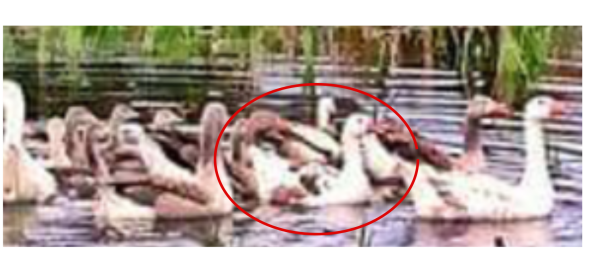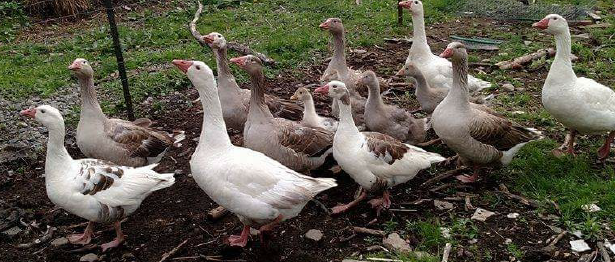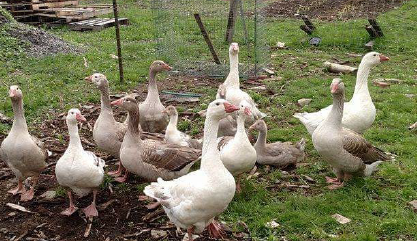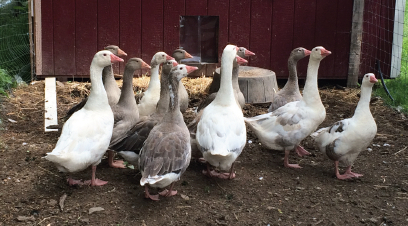PHILADELPHIA LINE Introduction
By: Faye Mast
This article gives the history of my Philadelphia line of Old English, Cotton Patch geese. Old English geese are repeatedly referenced in this article that Brandon Everette wrote. He writes about the geese he discovered and subsequently started the conservation of this wonderful line of the Cotton Patch geese. The Old English geese were originally thought to be a different landrace geese from the Cotton Patch geese of the south. But as more data was gathered it became apparent that these were simply a northern line of the southern landrace of Cotton Patch geese. At a later point, I will write a blog post about the Old English geese.
Discovery
By: Brandon Everett
In short: I identified a line of Old English, Cotton Patch, geese in 2016 and was able to trace its history back 30 years to its original home near Philadelphia. These geese were misrepresented as Pilgrim geese by their original owner. I no longer breed these geese, but hope to do so again one day. You are welcome to contact me if you have questions about the line. Email braeveokapi4@yahoo.com.

birds in the photo, which was originally posted on Facebook by the owner.
On May 7th, 2016 I came across a photo of someone’s newly purchased “pilgrim” gaggle posted on a Facebook poultry group. I took the initiative to message her because I thought I could see a saddleback bird in the photo, leading me to be suspicious as to whether the gaggle really was Pilgrim geese. She responded with, “Yes you are correct. It’s a male pilgrim, with a saddle.”
Immediately I was a little enthusiastic, as this was clearly not a male Pilgrim with a saddle. This appeared to be a gaggle of my most beloved race of geese and `they were not far from home.
I then asked how sure she was about the sex of the saddleback bird and what color the bills and feet were. She responded with, “No I am not certain. The bills & feet are more on the pink side, like my Sebbies*. This flock, 25 percent of the time throws this pattern. I was told this by the lady who had them. She said the flock has been closed for over 20 years.”

I then requested photos of the birds and she sent some. The photos showed 14 geese with very pink bills and feet, ranging in ages. There were three adult white birds, two adult saddleback birds, one very young saddleback bird, five adult grey birds, and three very young grey birds. Below are the photos she sent me of the gaggle.
On June 21st, 2016 I drove to the lady’s farm and spoke with her. At the time, she had nothing more to add about the geese other than what she had already discussed with me via messages.
However, she did tell me the name of the woman she purchased the gaggle from, but I was not able to get her contact information. I left the farm with a trio of birds, one white gander, one grey goose, and one saddleback goose I assumed was younger than the other two, but she was no longer a gosling either.

I took these photos of the gaggle because I wanted to give the birds a thorough look-over and confirm my suspicions on a visual basis that they were Cotton Patch geese. By this time, the young birds had grown significantly. The grey goslings are mostly to the back left in these photos and can be distinguished by a lack of white about their face or necks. Unfortunately, the young saddleback had died before I visited the farm. One of the ganders had more grey about his body than the other two, but it was not unreasonable. I could tell by his defensive posture, heightened chest, and high-pitched honking that the bird was a gander. Interestingly, he, like the other two ganders, was significantly larger than the female geese. This line appeared to not only be sexually dimorphic by plumage color, but also by size. This is not necessarily atypical of geese, as ganders are often larger. The saddleback geese and grey goose with the most white about her head and neck were the smallest of the bunch.
On July 16th, 2016 the gaggle owner answered my message in which I inquired about any other word from the original owner on the origin of the gaggle. She wrote back, “The lady I got them from said she purchased the entire flock [of] the pilgrims and two English saddlebacks from a lady down in the Philadelphia area she cannot remember her name and does not have contact information. The lady she got them from told her what they were when she purchased them that they were the last of her remaining flock.”

On July 18th, 2016 I contacted her again and asked her which previous owner had the flock for 20+ years. She responded with “[name omitted for privacy] has had this flock for 6 years I believe. The other lady [from Philadelphia] had it closed, no new blood, from other geese, was added to the flock for 20+ years.”
Shortly after I visited her farm and purchased the trio, she sold a few of the other geese: one gander, and three grey geese (4 total); leaving her with a gander, a saddleback goose, and five grey geese (6 total). I have no record of who purchased those birds, but I have little faith they became a part of any conservation-breeding project because she sold them as Pilgrims and not Old English geese (I think at this point, she thought I was crazy and following some romantic fantasy of discovering these geese that she has never even heard of)”.
So, at this point, there were only two ganders, two saddleback geese, and six grey geese (9 total) that could be used to repopulate this line. I eventually revisited her farm and purchased a second grey goose, giving me a total of 4 birds to use for my breeding project.

Breeding in the spring of 2017 was very successful, with a healthy brood of goslings. You can see the gaggle pictured here, proudly walking with their brood. While I did have some goslings hatch in both 2018 and 2019, I did not have as many as in 2017. I believe this was mostly due to the increase in the number of birds (saved from the 2017 hatch) and with that increase, habits such as territorial disputing, and nest sharing. It was, of course, my own fault for failing to provide enough secluded spaces for nesting.
I never separated the flocks into pairs for breeding purposes, they were run as an open flock. I say “flocks” because I raised the Norman line of Old English, Cotton Patch geese from 2013 until the winter of 2016, but I never let the two intermingle in their short time together. I wanted to keep the lines as pure as possible.
*Sebastian geese
** Pilgrim geese males are white and females are gray with white underneath.
Footnotes added by Faye Mast
